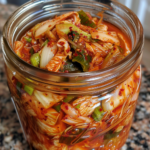Last Updated on May 3, 2025 by recipeinspire
Table of Contents
Homemade Kimchi: A Step-by-Step Guide to Perfect Fermentation

Making homemade kimchi is a rewarding kitchen adventure that brings a taste of Korea right into the home. Homemade kimchi not only allows for customization of flavors and ingredients but also provides numerous health benefits due to its natural fermentation process. This popular dish is versatile and can be enjoyed in various meals, making it a perfect addition to anyone’s recipe collection.
The process of making kimchi is steeped in history, reflecting a rich cultural tradition. Understanding the origins can deepen one’s appreciation of this side dish. With the right ingredients and techniques, anyone can create authentic kimchi that suits their taste preferences.
Whether you are new to cooking or a seasoned chef, making kimchi can enhance your culinary skills. Delving into the world of fermentation opens the door to delicious flavors and preserved foods, encouraging creativity in the kitchen.
Key Takeaways
- Making kimchi at home offers health benefits from fermentation.
- Selecting fresh ingredients is crucial for authentic flavor.
- Proper fermentation and storage extend the shelf life of kimchi.
Historical Background of Kimchi
Kimchi has a rich history that reflects its cultural importance in Korean cuisine. This section explores its origins, how it has evolved, and the diverse regional variations that exist today.
Origins and Significance
The origins of kimchi date back thousands of years. Early versions were simple pickled vegetables used for preservation. The introduction of fermentation marked a significant milestone, enhancing flavor and shelf-life.
Kimchi’s significance extends beyond being a dish. It embodies Korean identity and family traditions. In Korea, sharing kimchi during meals signifies hospitality and community. As households developed their own recipes, it became a way to express cultural heritage.
Evolution Over Time
Kimchi has transformed through various historical phases. Initially, it consisted mainly of salted vegetables, like napa cabbage and radishes. With the arrival of new ingredients, especially during the late 16th century, the recipe evolved to include spices like gochugaru, making it more complex and flavorful.
The industrial era brought mass production of kimchi. This change made it accessible to a broader audience while maintaining its cultural roots. The dish has now gained international recognition, celebrated for its health benefits and unique taste.
Regional Variations
In Korea, different regions produce distinct types of kimchi. For instance, napa cabbage kimchi is popular in the north, while kkakdugi, or cubed radish kimchi, is favored in the south. Each region uses local ingredients and spices, leading to unique flavors and textures.
Additionally, seasonal variations exist. Summer kimchi, light and refreshing, contrasts with winter kimchi, which is heartier and spiced for warmth. This diversity reflects the agricultural practices and climate conditions of different areas, enriching the kimchi tradition.
Health Benefits of Kimchi
Kimchi offers a variety of health benefits due to its rich nutritional profile. Its ingredients contribute to good digestion and may also help in preventing certain diseases.
Nutritional Composition
Kimchi is low in calories while being high in essential nutrients. It is often made with ingredients like Napa cabbage, radishes, garlic, and spices.
A typical serving provides:
- Vitamins: Rich in vitamin A, C, and K.
- Minerals: Contains calcium, potassium, and magnesium.
- Fiber: Promotes better gut health.
A one-cup serving of kimchi has about 23 calories, making it a nutritious addition to meals. It provides ample nutrition without excessive calories, supporting weight management. The variety of ingredients ensures a broad spectrum of nutrients, enhancing its health benefits.
Probiotics and Digestive Health
Fermentation is key to kimchi’s health benefits. During fermentation, beneficial bacteria known as probiotics develop. These probiotics enhance gut health and digestion.
Probiotics help:
- Balance intestinal flora
- Improve nutrient absorption
- Reduce symptoms of digestive disorders
Regular consumption of kimchi may lead to a healthier gut. It can aid in preventing constipation and bloating, making it a great food for digestive wellness. Additionally, probiotics can boost the immune system, further supporting overall health.
Potential for Disease Prevention
Numerous studies suggest that kimchi may lower the risk of several serious health conditions. Its combination of antioxidants, vitamins, and probiotics plays a role in this protective effect.
Some potential benefits include:
- Heart Health: Ingredients like garlic can support cardiovascular health.
- Cancer Prevention: Antioxidants may reduce cancer risk.
- Diabetes Management: Low-calorie content helps in blood sugar control.
Eating kimchi regularly can contribute to a well-rounded diet, potentially lowering the risk of chronic diseases. Its nutritious profile makes it a valuable addition to meal plans aimed at disease prevention.
Selecting Ingredients
Choosing the right ingredients is crucial for making delicious homemade kimchi. Each component plays a significant role in flavor and texture. Here are the best options for cabbage, spices, and produce to ensure a successful batch.
Best Varieties of Cabbage
The most popular choice for kimchi is napa cabbage. This type is tender and has a high water content, which aids in fermentation. It is also slightly sweet, balancing the spiciness of kimchi.
Another option is green cabbage, which has a firmer texture. While it may not produce the same flavor as napa cabbage, it still makes a great kimchi.
When selecting cabbage, look for heads that are heavy and crisp. Avoid those with blemishes or soft spots. Freshness is key to ensuring a crunchy, flavorful end product.
Essential Spices and Seasonings
Kimchi’s flavor comes from a blend of spices and seasonings. Key ingredients include Korean red pepper flakes (gochugaru), which give the dish its signature heat and color.
Other vital seasonings are garlic and ginger. They add depth and complexity to the flavor profile.
Additionally, fish sauce or salted shrimp provides umami, enhancing the overall taste. Variations exist, but these ingredients form the base of most traditional recipes.
Balancing these elements can make the kimchi more appealing. Adjust the amount of spice based on personal heat preference.
Choosing Quality Produce
When making kimchi, quality matters. Fresh vegetables contribute to better taste and texture. It is essential to select vibrant, unblemished produce.
For radishes, another common ingredient, choose firm ones. They should be crisp as they add crunch to the final product.
Scallions are often used for garnish and flavor. They should be green and firm at the tops.
Buying organic can also make a difference in flavor and nutritional value. Overall, fresher ingredients yield tastier kimchi.
Preparation Techniques
Making kimchi involves several key steps to ensure the flavors and textures are just right. Each part of the preparation process contributes to the final taste and quality of the dish.
Washing and Cutting
To start, it is important to properly wash the napa cabbage. This removes dirt and any residues. After rinsing, the cabbage should be cut into quarters lengthwise.
Remove the core from each quarter. This step is essential as it helps the cabbage absorb salt and seasoning more effectively.
The cabbage pieces can be further cut into smaller sections if desired. This will make it easier to pack into jars later on.
Additionally, other vegetables, such as radishes and carrots, should be prepared at this stage. They must be washed and cut into matchstick shapes to blend well with the cabbage.
Salting and Brining
Once cut, the cabbage needs to be salted. Sprinkle sea salt evenly over each leaf, ensuring all surfaces are coated.
This process draws out excess moisture, allowing the cabbage to soften. After salting, the cabbage should rest for 1 to 2 hours.
Cover it with a plate weighted down to keep it submerged in its own juices. It is important to turn the cabbage halfway through to ensure even salting.
When the time is up, rinse the cabbage thoroughly under cold water to remove excess salt. This step balances the flavors and prevents the kimchi from being too salty.
Mixing and Seasoning
The next step involves making the kimchi paste. In a bowl, combine ingredients like grated ginger, minced garlic, and Korean red pepper flakes.
Some recipes also include fish sauce and sugar, which add depth to the flavor.
When the paste reaches the desired consistency, it is ready to mix with the cabbage.
Add the cabbage to the bowl and use hands (gloved, if preferred) to massage the paste into the leaves, ensuring even coverage.
To finish, chop green onions and add them to the mixture, enhancing the overall flavor and texture. The kimchi is then packed tightly into jars, making sure to push out any air bubbles.
Fermentation and Storage
Fermentation is a key process in making homemade kimchi, as it develops flavors and preserves the vegetables. Proper storage after fermentation is equally important to maintain quality and taste.
Controlling Fermentation
The fermentation process begins once the kimchi is prepared and packed into containers. To control fermentation, the producer should monitor the temperature and duration. Factors such as the ingredients and room temperature will affect how quickly fermentation occurs.
For best results, initial fermentation should occur at room temperature for 1 to 2 days. After that, the kimchi should be transferred to the refrigerator. This slows down the fermentation, preserving the desired taste while allowing flavors to develop gradually.
Containers and Sealing
Using the right container is crucial for successful kimchi storage. It should be airtight to minimize air exposure, which can spoil the kimchi. Glass jars, such as mason jars, or plastic containers designed for fermentation work well.
When sealing, leave some space at the top of the container. This allows for gas release during the fermentation process. Periodically, the container should be checked for pressure buildup and burped if necessary to release any excess gas.
Temperature and Duration
Temperature greatly affects the fermentation rate of kimchi. Ideally, the refrigerator should be set between 32°F and 39°F (0°C to 4°C). This range helps slow fermentation without stopping it completely.
As for duration, kimchi can last several weeks or even months in proper conditions. It is important to regularly taste the kimchi to check the flavor and texture. If it becomes too strong or sour, it may be time to consume or use it in recipes.
Frequently Asked Questions
Many people have questions about making homemade kimchi. This section addresses common queries related to ingredients, fermentation time, vegan options, recipe differences, cost-effectiveness, and health benefits.
What are the essential ingredients for making traditional kimchi at home?
Traditional kimchi typically requires napa cabbage, Korean radish, garlic, ginger, green onions, and Korean red pepper flakes (gochugaru). These ingredients create the foundation of flavor. Additionally, salt is crucial for brining and promoting fermentation.
How long should kimchi be left to ferment before it’s ready to consume?
Kimchi should ideally ferment at room temperature for about one to two days, depending on the desired tanginess. After this period, it can be moved to the refrigerator where fermentation slows down but continues over time. Homemade kimchi can be enjoyed once it has reached a satisfactory taste.
Can kimchi be made in a vegan-friendly way, and if so, how?
Yes, kimchi can be made vegan by avoiding fish sauce or shrimp paste commonly found in traditional recipes. Instead, people can use soy sauce or miso to add depth of flavor. Many recipes also include a variety of vegetables to enhance the taste.
What is the difference between kimchi recipes using Gochujang paste and those that do not?
Recipes using Gochujang, a fermented chili paste, tend to result in a sweeter and spicier kimchi. In contrast, recipes without Gochujang usually rely more on gochugaru for heat and flavor, creating a different texture and taste profile. The choice depends on personal preference for heat and flavor complexity.
Is preparing kimchi at home more cost-effective compared to purchasing it?
Generally, making kimchi at home can be more cost-effective than buying it from stores. Bulk ingredients like napa cabbage and spices can be purchased at lower prices. Additionally, homemade kimchi often provides more servings compared to store-bought options.
What health benefits are associated with consuming homemade kimchi?
Homemade kimchi is rich in probiotics due to the fermentation process. These probiotics can aid digestion and support gut health. Moreover, kimchi is low in calories but high in vitamins A, C, and K, making it a nutritious addition to meals.
Print
Homemade Kimchi (Kimchee)
Description
Making homemade kimchi is a rewarding kitchen adventure that brings a taste of Korea right into the home. Homemade kimchi not only allows for customization of flavors and ingredients but also provides numerous health benefits due to its natural fermentation process.
Ingredients
Napa cabbage (1 large)
Salt (1/4 cup)
Water (4 cups)
Carrot, julienned (1)
Green onions, chopped (4)
Garlic, minced (5 cloves)
Ginger, grated (1 tbsp)
Korean red pepper flakes (2 tbsp)
Fish sauce (2 tbsp)
Sugar (1 tbsp)
Instructions
Chop cabbage and soak in salt water for 2 hours. Rinse and drain.
Mix cabbage with carrot, green onions, garlic, ginger, red pepper flakes, fish sauce, and sugar.
Pack tightly into a jar and let ferment at room temperature for 2-5 days.
Keywords: Homemade Kimchi
More Recipes :








